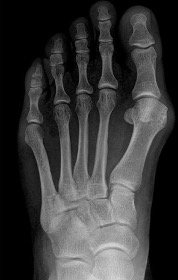The painful bunion
What is a bunion?
Bunions, also known as hallux valgus, are a 3-dimensional deformity of the big toe. The 1st metatarsal bone angles away from the 2nd metatarsal, giving the appearance of a bump at the inside of the toe and causes pain in this area. Often, the big toe is also elevated and rotated which leads to abnormal pressures and imbalance through the forefoot.
The exact cause of bunions is unknown, but there are several contributing factors that can increase the risk of developing them. Genetics, foot structure, and footwear can all play a role. People with flat feet or low arches, as well as those who wear tight or narrow shoes that squeeze the toes together, are at an increased risk of developing bunions.
Diagnosis and X-ray
Physical examination and X-rays are essential in diagnosing bunions. A physical examination includes observing the foot and testing the range of motion of the big toe. During the examination, we look for skin problems, calluses, tenderness and the overall shape and structure of the foot. Problems with the other toes should be checked at the same time.
Standing X-rays are used to assess the severity of the bunion deformity and to determine the appropriate course of treatment. The X-rays help us to assess the bunion’s severity by measuring the angle between the first metatarsal bone and the big toe, as well as the degree of rotation of the metatarsal bone. They also reveal signs of arthritis or joint damage. CT scans and MRIs are typically not needed.
Treatment
Nonoperative treatment options for bunions include changing footwear, using devices such as spacers/braces, and taking over-the-counter pain medications. Changing footwear involves wearing shoes that are wider and have a lower heel to decrease pressure on the bunion. Some patients with arch problems can benefit from orthotics. Over-the-counter pain medications (oral or topical) can help to reduce pain and inflammation associated with bunions. Unfortunately, a bunion is a structural problem that cannot be completely eliminated by these strategies, but the symptoms of a bunion can be effectively managed.
If nonoperative treatments are not successful, surgery is considered for pain and functional limitations. The goal of bunion surgery is to realign the bones, ligaments, tendons, and joints of the foot, and to relieve pain and improve function. There are several surgical options available, and the type of surgery chosen will depend on the severity of the bunion deformity, the age and activity level of the patient, and other medical conditions.
Minimally-invasive bunionectomy
Minimally-invasive (MIS) bunion correction is best for patients with a mild to moderate-sized bunion. There are smaller incisions and less soft tissue scarring. The bone is cut in two places (osteotomy) and shifted into the desired alignment. Excess bone is shaved away and the toe is straightened. Screws are inserted to hold the bone until it heals, but typically never need to be removed. Learn more about MIS bunion surgery.
Modified Lapidus Procedure
A modified Lapidus procedure (commercial name Lapiplasty) can help those with larger bunions or with arthritis at the midfoot. The correction straightens the first metatarsal from its base and eliminates any instability from the 1st tarsometatarsal (TMT) joint. The bones are held with plates and screws until healing. Motion will still be maintained at the big toe. Learn more about the Lapiplasty procedure.
Surgery is typically performed on an outpatient basis. Following surgery, patients will be advised to wear a splint for two weeks, followed by a surgical boot. The foot has to be protected with no weight on it for a period of time. Exact recovery time varies depends on the procedure performed and each individual’s pace of healing. Most patients are back to sneakers around 6 weeks after surgery.
Get evaluated for your bunion and learn about all the options.
Discuss with Dr. An your goals of care and find the best procedure suited to you.
While many do not require surgery, a bunion that is ignored for too long can be much harder to treat.















